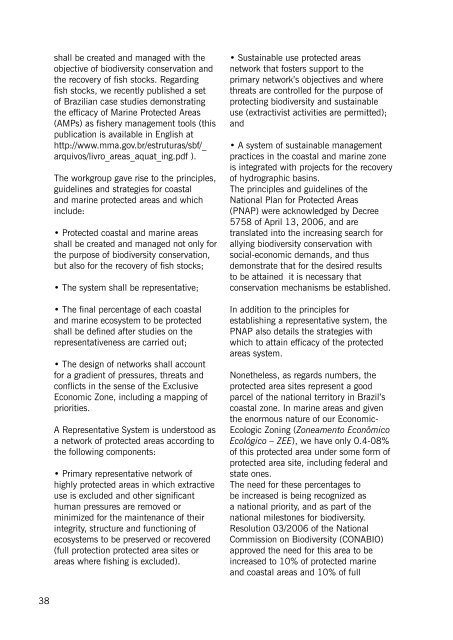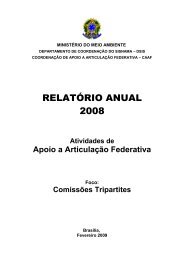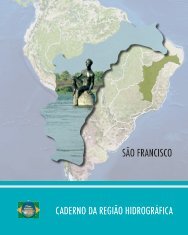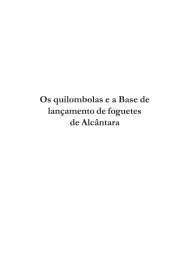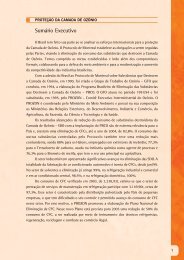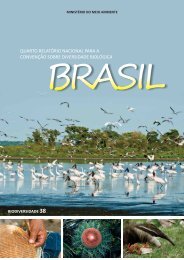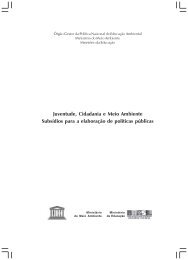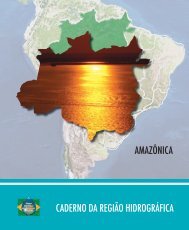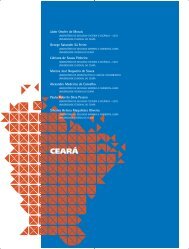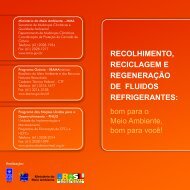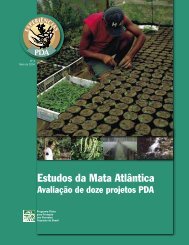Protected Areas
Protected Areas
Protected Areas
- No tags were found...
You also want an ePaper? Increase the reach of your titles
YUMPU automatically turns print PDFs into web optimized ePapers that Google loves.
shall be created and managed with theobjective of biodiversity conservation andthe recovery of fish stocks. Regardingfish stocks, we recently published a setof Brazilian case studies demonstratingthe efficacy of Marine <strong>Protected</strong> <strong>Areas</strong>(AMPs) as fishery management tools (thispublication is available in English athttp://www.mma.gov.br/estruturas/sbf/_arquivos/livro_areas_aquat_ing.pdf ).The workgroup gave rise to the principles,guidelines and strategies for coastaland marine protected areas and whichinclude:• <strong>Protected</strong> coastal and marine areasshall be created and managed not only forthe purpose of biodiversity conservation,but also for the recovery of fish stocks;• The system shall be representative;• The final percentage of each coastaland marine ecosystem to be protectedshall be defined after studies on therepresentativeness are carried out;• The design of networks shall accountfor a gradient of pressures, threats andconflicts in the sense of the ExclusiveEconomic Zone, including a mapping ofpriorities.A Representative System is understood asa network of protected areas according tothe following components:• Primary representative network ofhighly protected areas in which extractiveuse is excluded and other significanthuman pressures are removed orminimized for the maintenance of theirintegrity, structure and functioning ofecosystems to be preserved or recovered(full protection protected area sites orareas where fishing is excluded).• Sustainable use protected areasnetwork that fosters support to theprimary network’s objectives and wherethreats are controlled for the purpose ofprotecting biodiversity and sustainableuse (extractivist activities are permitted);and• A system of sustainable managementpractices in the coastal and marine zoneis integrated with projects for the recoveryof hydrographic basins.The principles and guidelines of theNational Plan for <strong>Protected</strong> <strong>Areas</strong>(PNAP) were acknowledged by Decree5758 of April 13, 2006, and aretranslated into the increasing search forallying biodiversity conservation withsocial-economic demands, and thusdemonstrate that for the desired resultsto be attained it is necessary thatconservation mechanisms be established.In addition to the principles forestablishing a representative system, thePNAP also details the strategies withwhich to attain efficacy of the protectedareas system.Nonetheless, as regards numbers, theprotected area sites represent a goodparcel of the national territory in Brazil’scoastal zone. In marine areas and giventhe enormous nature of our Economic-Ecologic Zoning (Zoneamento EconômicoEcológico – ZEE), we have only 0.4-08%of this protected area under some form ofprotected area site, including federal andstate ones.The need for these percentages tobe increased is being recognized asa national priority, and as part of thenational milestones for biodiversity.Resolution 03/2006 of the NationalCommission on Biodiversity (CONABIO)approved the need for this area to beincreased to 10% of protected marineand coastal areas and 10% of full38


